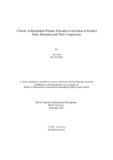| dc.contributor.advisor | Saha, Somnath | |
| dc.contributor.author | Amer, Asif | |
| dc.date.accessioned | 2021-11-17T07:19:08Z | |
| dc.date.available | 2021-11-17T07:19:08Z | |
| dc.date.copyright | 2021 | |
| dc.date.issued | 2021-09 | |
| dc.identifier.other | ID 19357049 | |
| dc.identifier.uri | http://hdl.handle.net/10361/15624 | |
| dc.description | This thesis is submitted in partial fulfilment of the requirements for the degree of Masters of Science in Early Child Development, 2021. | en_US |
| dc.description | Cataloged from PDF version of thesis. | |
| dc.description | Includes bibliographical references (pages 100-106). | |
| dc.description.abstract | The world is undergoing a massive crisis that can be described as a "peace crisis." This can be seen in the rise of violence and conflict in society, even among youth. To prevent violence and conflict and to instill the correct mentality necessary for social cohesion from an early age, "Peace Education '' is thought to be critical in early childhood education. This study was conducted to ascertain the steps, actions, contents, and practices of Bangladesh's progress in realizing peace education in the primary education curriculum and textbooks. To realise the study, as the primary research tool document analysis was used to perform detail analysis on the social science textbooks and curriculum of grades one to five in Bangladesh primary education. Five in-depth interviews with teachers were performed to ascertain their perspectives on peace education and its current state in primary education. Additionally, the areas for improvement for peace education material have been identified to develop a resilient new generation that is extraordinarily strong in the face of conflict and violence. The findings indicated that peace education is available in a minimal and disorganized manner in Bangladesh primary education. There has been minimum intervention from government to train instructors or give expertise, in the area of peace education, but there have been a few instances of NGOs providing training independently. However, to establish a standard of peace education, appropriate curricular inclusions are required. As a recommendation, it has been urged that peace education to be recognized as a formal teaching material that should be methodically and fully integrated into the curriculum. It is proposed that teachers should have enough pre- and post-service training on peace education and its teaching methods, as well as access to an appropriate guideline. This would aid in the development of togetherness, brotherhood, and empathy for nations' actions against conflicts through peace education. | en_US |
| dc.description.statementofresponsibility | Asif Amer | |
| dc.format.extent | 111 pages | |
| dc.language.iso | en | en_US |
| dc.publisher | Brac University | en_US |
| dc.rights | BRAC University thesis reports are protected by copyright. They may be viewed from this source for any purpose, but reproduction or distribution in any format is prohibited without written permission. | |
| dc.subject | Peace education | en_US |
| dc.subject | Cohesion | en_US |
| dc.subject | Curriculum | en_US |
| dc.subject | Conflict | en_US |
| dc.subject | Violence | en_US |
| dc.subject | Civic responsibility | en_US |
| dc.subject.lcsh | Peace--Study and teaching | |
| dc.subject.lcsh | Education, Elementary | |
| dc.title | A study on Bangladesh primary education curriculum to explore peace education and their components | en_US |
| dc.type | Thesis | en_US |
| dc.contributor.department | Institute of Education Development, BRAC University | |
| dc.description.degree | M. Early Child Development | |

